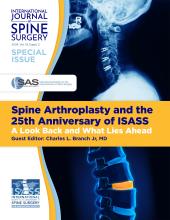Abstract
Background Intramuscular myxomas (IMs) are rare benign neoplasms of fibroblastic origin, typically presenting in adults, with a female predominance. IMs are uncommonly located in the skeletal muscles, most frequently in the thighs, but rarely in the paraspinal region. IM may be located deeply in this region and that could present a challenge for complete resection.
Case Presentation A 66-year-old woman presented with progressive lower back pain and radicular symptoms, which were due to a paraspinal IM.
Case Management The patient underwent a minimally invasive microsurgical resection assisted by a 45° endoscopic microinspection tool (QEVO) to enhance visualization and access the lateral compartment of the tumor. Microsurgical dissection assisted with endoscopic visualization allowed successful resection of the tumor, including its lateral compartment, without extensive muscle transection. No complications occurred during or after surgery, and the patient reported complete symptom relief with no recurrence after 2 years.
Technology This case demonstrates the value of integrating endoscopic tools in spinal surgery, particularly in cases where conventional microsurgical techniques are insufficient for complete tumor resection using less invasive approaches. The enhanced visualization provided by the 45° endoscope facilitated the successful resection of a paraspinal lesion, improving surgical precision and patient outcomes.
Conclusions The QEVO microinspection tool is an effective adjunct to microsurgical techniques, offering enhanced visualization and precision during tumor resection. This case highlights its potential to address the challenges posed by deeply located paralumbar tumors. As further research explores its use in spine surgery, this microinspection tool could become an important asset in minimally invasive spinal tumor resections, improving patient outcomes through better tissue preservation and complete resection.
Level of Evidence 5.
Introduction
Myxomas are benign neoplasms of fibroblastic origin that structurally resemble the umbilical cord, consisting of stellate cells in a loose myxoid stroma with poor vascularity.1,2 Despite being rare tumors, intramuscular myxomas (IMs) are the most common mainstream myxomas of soft tissues and occur along any skeletal muscle.2 The occurrence rate of IM ranges between 0.1 and 0.3 per 100,000 individuals.3 Myxomas mainly arise in adults between the fifth and eighth decades of life, and 66% of cases present in women.4 Most IMs are asymptomatic or are discovered incidentally as painless growing masses in the muscles of the thigh. Rare case reports have documented IM in the paraspinal muscles, with approximately 40% of these cases occurring in the lumbar spine.5 Current treatment advocates for total surgical resection. The long-term biological behavior of the tumor is benign, with no significant risk of distant metastasis and a low potential for local recurrence.6,7 The present article reports a rare lumbar paraspinal IM resected using a minimally invasive microsurgical approach assisted with a 45° endoscopic microinspection tool (QEVO by ZEISS).
Case Report
A 66-year-old woman began experiencing progressive mild lower back pain radiating toward the right leg. Conservative treatment with nonsteroidal anti-inflammatory drugs, muscle relaxants, and a facet and radicular block was performed in a different medical center; however, the patient’s pain episodes increased in frequency and intensity. Physical examination showed decreased muscle strength of the right leg (4/5 on Daniels scale) and slight hypoesthesia in the right L3 and L4 dermatomes. Lumbar spine magnetic resonance imaging revealed a right intramuscular cystic paravertebral lesion affecting the L3 to L4 nerve root adjacent to the facet joint (Figure 1). Based on our initial evaluation, surgical exploration was recommended.
Pre- and postoperative lumbar magnetic resonance images (MRI). Preoperative imaging revealed a lobulated, well-defined lesion with a cystic appearance, measuring 5 × 5.4 × 5.5 cm, at the L3 to L4 level. Postoperative MRI showed complete resection with minimal fascia and paraspinal musculature transgression. (A) Preoperative axial T2-weighted image showed a hyperintense lesion. (B) Preoperative axial T1-weighted image showed a hypointense lesion. (C) Preoperative coronal T2-weighted image. (D) Preoperative sagittal T2-weighted image. (E) Preoperative sagittal T1-weighted image. (F) Postoperative axial T2-weighted image. (G) Postoperative axial T1-weighted image. (H) Postoperative coronal T2-weighted image. (I) Postoperative sagittal T2-weighted image. (J) Postoperative sagittal T1-weighted image.
The surgical procedure involved a paralumbar approach using a 3-cm incision. The procedure began with microscopic visualization utilizing the Kinevo microscope. Intralesional tumor biopsies and decompression were performed using aspiration, dissection, and biopsy forceps facilitated by the tumor’s soft consistency and low vascularity. However, the lateral compartment of the tumor was found beyond the reach of the microsurgical view. To overcome this limitation, the lateral compartment of the tumor was effectively resected using a 45° endoscopic microinspection device (QEVO). This allowed us to complete the resection under the thoracolumbar fascia without fully transecting the paralumbar muscles. No complications were observed during or after the procedure (Video 1 and Figure 1). The patient reported complete relief of her symptoms and remains asymptomatic after 2 years. The histopathological report revealed an IM, and the immunohistochemistry study showed focal CD34 and Ki67 1% (Figure 2).
Histopathological findings. (A–D) Hematoxylin and eosin staining show a hypocellular lesion composed of spindle-shaped, monomorphic cells with a benign appearance, scant cytoplasm, and pale eosinophils. The nuclei are small and oval. These cells are embedded in an abundant stroma with myxoid characteristics, accompanied by a network of fine capillaries. Morphological findings were compatible with IM (magnification: A, 4×; B, 10×; C, 20×; and D, 40×). (E) Alcian blue stain is positive in the stroma. (F) Immunohistochemistry for CD34 shows focally positive cells with a proliferation index of 1%, as determined by Ki67 staining.
Discussion
Myxomas are benign neoplasms originating from embryonic mesenchymal cells.8,9 Although this type of tumor is most common in the right atrium of the heart, it can arise almost anywhere. These neoplasms are characterized by their abundant myxoid matrix and poor vascularity.2
There are 24 reported cases of paraspinal IMs in the literature.7–10 Of these, 10 were in the cervical spine, 2 in the thoracic spine, and 12 in the lumbar spine. Typically, patients presented with intermittent lower back pain and radicular symptoms, although some were asymptomatic. Those who were previously symptomatic generally became asymptomatic after the procedure, with no recurrence of the tumor (Table).
Reported cases of paraspinal intramuscular myxomas.
IMs typically occur in adults between the third and sixth decades of life, with a notable predominance in women (12:1 ratio).14,27 While they are primarily found in long muscles such as those in the thigh, shoulders, buttocks, and upper extremities, few cases have been documented in the spine, particularly the cervical and lumbar regions. Surgical resection is the only curative treatment, and recurrence is very rare.28 Despite this, there are no established guidelines for the surgical approach to these tumors.
In the patient described in the present report, a microsurgical resection was initially attempted. However, the lateral compartment of the tumor was beyond the reach of the microsurgical view. To address this challenge, an endoscopic microinspection device (120 mm × 3.6 mm) with a 45° viewing angle was employed. The device’s 45° angle allowed an expanded field of view, allowing for a detailed examination and dissection of the tumor while preserving the paraspinal musculature. The enhanced visualization capabilities provided by the endoscope were crucial in achieving a complete resection of the lesion, which was otherwise inaccessible through a small incision.
The QEVO endoscopic microinspection tool, integrated into the Kinevo digital visualization platform, has demonstrated successful applications in both cadaveric studies and clinical practice. It has proven valuable in tumor and aneurysm surgeries to detect hidden tumor remnants or assess aneurysm clip placement, particularly in challenging anatomical regions. Separate clinical cases by Belykh et al29 and Schebesch et al,30 including middle cerebral artery aneurysm clipping, cerebellar cavernoma removal, and pituitary adenoma resection, have highlighted the tool’s ability to enhance visualization of deep structures and improve surgical precision. Similarly, additional case series have underscored the QEVO tool’s ability to navigate complex surgical exposures, such as the posterior fossa and ventricular space, where acute angles and blind spots limit standard microscopic visualization.31,32 The tool provides high-resolution imaging and depth perception for neurovascular structures, with a wide viewing angle that expands the surgeon’s field of vision. Notably, its ergonomic design allows for precise and controlled handling under direct microscopic visualization, ensuring safe maneuvering around delicate neurovascular structures. Unlike traditional endoscopes, the QEVO microinspection device offers significant practical advantages, including its fast setup, seamless integration with the Kinevo platform, and on-demand usability without the need for additional preparation or an endoscope tower. Despite some limitations, such as its short length and reliance on the Kinevo platform, the QEVO microinspection tool remains innovative and efficient in addition to neurosurgical techniques, enhancing safety, precision, and workflow efficiency.29–32
The use of the QEVO microinspection tool has been mainly used in intracranial surgeries, and its use in spinal surgeries has been less documented. Feigl et al reported a case where the tool was successfully used for a giant hernia resection.33 We believe that this area warrants further exploration, as the endoscopic microinspection tool has the potential to improve angled complex visualization in degenerative spinal diseases or spinal tumors, especially as an adjunct in microscopic procedures to enhance ergonomy and surgical precision.
The QEVO microinspection tool offers excellent haptic properties and provides a high-resolution view at a 45° angle. Additionally, the 45° view and angled instruments allow the surgeon to maintain a more comfortable position without the need to adjust the microscope. However, the tool lacks an external holder, requiring a second surgeon to dynamically hold the endoscope during the procedure. Despite this, visualization can be rapidly alternated between microscopic and endoscopic views, although it does not support 0° or 30° optics.
The successful integration of the endoscopic microinspection device in this procedure underscores its value in spinal surgeries. This case highlights the potential for endoscopic technology to improve surgical techniques, offering better outcomes through better visualization, precision, and tissue preservation.
Conclusion
The resection of a paralumbar myxoma presents unique challenges due to the tumor’s deep location. Successful management of such cases requires advanced visualization tools to ensure complete tumor removal while minimizing damage to surrounding tissues. The QEVO endoscopic microinspection tool, integrated with the Kinevo digital visualization platform, offers significant advantages in addressing these challenges. Its ability to enhance visualization in deep and complex surgical corridors, coupled with its ergonomic design and seamless operability, allows for precise resection of lesions in anatomically challenging regions.
In our case, the use of the QEVO tool facilitated exposure and inspection of concealed areas, ensuring the complete removal of the tumor. This case emphasizes the importance of adopting innovative surgical technologies to improve visualization for safer, less invasive, and more precise surgery in rare and complex tumors like paralumbar myxomas.
Acknowledgments
The authors would like to thank the pathology department for their detailed analysis and the radiology team for their assistance with imaging. We also extend our gratitude to the patient for her willingness to share her case, contributing to the advancement of medical knowledge.
Footnotes
Funding The authors received no financial support for the research, authorship, and/or publication of this article.
Declaration of Conflicting Interests The authors report no conflicts of interest in this work.
Author Contributions All authors contributed to the manuscript preparation and approved the final version of the manuscript.
- This manuscript is generously published free of charge by ISASS, the International Society for the Advancement of Spine Surgery. Copyright © 2025 ISASS. To see more or order reprints or permissions, see http://ijssurgery.com.









